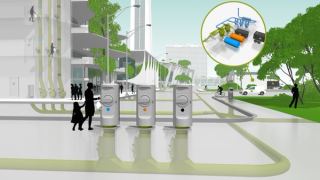
Automated waste collection scheme - feasibility of retrofit within urban area
- Client Name
- Confidential
- Location
- South East England, UK

Challenge
The client wished to consider the feasibility of installation and operation of an AWCS (also known as pneumatic waste collection systems) within two discrete dense urban, high footfall, and city areas.
AWCS involves the installation of below ground pipework, fed from the surface by waste inlets (for use by householders, businesses and as litter bins). The waste is moved using a vacuum to a more distant waste consolidation location.
Transition from current above ground bins, bags and waste stores to an underground system negates the need for the vast majority of waste collection vehicle trips, thereby improving the public realm, reducing congestion, noise, collision risks and improving air quality.
Solution
SLR has an in depth understanding of AWCS capabilities, requirements and limitations, having worked on numerous feasibility studies in the UK and and globally.
Applying this knowledge and experience, SLR helped the client gain a better understanding of AWCS, including its benefits and limitations, within the context of the specific study areas.
The feasibility study included development of waste profile forecasts, concept design options, and a high level cost model accounting for capex and opex of AWCS (allowing a comparison against the costs of traditional collection systems).
Impact
Two alternative methods of AWCS were proposed for the discrete study areas, based on the best alignment with the characteristics of each locality.
Analysis demonstrated that AWCS can deliver long term financial savings, in addition to the many and varied non-financial benefits of AWCS which help drive forward public realm improvements.

